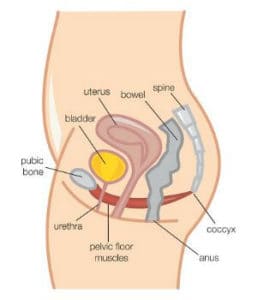What’s All This Hype About My Pelvic Floor Muscle?
Every pregnant woman has heard at least one person tell them to ‘do their pelvic floor exercises’
Yet for many people, the pelvic floor, or anything down around ‘the nether-regions’ is simply something that is not spoken about, or something they are never educated about.
Believe it or not, it’s very difficult to activate a set of muscles which you a) cannot see and b) know absolutely nothing about – and that can be very frustrating not only for our patients but also for us as practitioners, when we’ve completely run out of ideas for inspiration!
We find that for those who have a better understanding of the anatomy and function of these muscles, the strengthening and re-training side of things becomes significantly easier. Thus, I want to provide you with a bit of an info sheet for not just the preggy ladies out there, but for anyone who wants to get themselves a bit ‘better acquainted’ with their pelvic floor musculature.

Where are they, & what do they do?
The pelvic floor muscles are a sling of muscles that support your pelvic organs – Imagine a trampoline that spans the bottom of your pelvis from front to back, and also side to side.
Just like a trampoline, they are able to move up and down. There are holes in your pelvic floor for passages to travel through – three in women, and two in men. These help to control the passing of urine, faces and wind at a time that is convenient for you!
They play a massive role in both continence and sexual health (so they’re pretty damn important!)
Why Might they be Weak?
They might be weak for a number of reasons, including:
- Pregnancy, or multiple pregnancies
- Heavy lifting
- Constipation
- Being overweight
- Not keeping them active
How do I activate them?
Firstly, you need to ensure that you are activating the correct muscles, as doing the exercises poorly can sometimes do more harm than good!
Lie down or sit, with buttocks, thighs and abdominal muscles relaxed. Try to be in a quiet room – distractions make it much harder.
Gently squeeze the ring of muscle around the back passage, as if trying to stop yourself from passing wind. Then relax. Try this 4-5 times, trying to isolate the muscles without clenching your buttocks.
You can also try whilst sitting on the toilet: try to stop the flow of urine mid-stream. Only try this a couple of times just as a check– doing it regularly can affect your bladder emptying routine!
You should feel a ‘lift and squeeze’ as you do the exercise. If you are struggling to isolate these muscles, check in with your doctor, midwife or physiotherapist and see if they can help you out!
How should I train them? How strong should they be?
Ideally, you would be able to hold a pelvic floor activation for 10x 10 seconds. However, this is harder than it seems!
Start by concentrating, performing a lift and see the maximum amount of time you can hold it for. Use this as a bit of a guide for your sets and repetitions.
E.g. if you can hold for 6 seconds, then start with 10x 6 second activations, then gradually build up from there.
You should aim to do 3x sets of holds, at whatever duration you can, 2-3x per day.
Having said that, a few squeezes is better than nothing, so try and do them whenever you remember!
How can my physio help with such a thing?
Your physiotherapist is well equipped to help you learn about your pelvic floor muscles, teach you how to activate them and also give you specific exercises to help you strengthen.
At Viva Physiotherapy, we have a Real Time Ultrasound machine which shows us how your muscles are activating in ‘real time.’ We can visually show you what a good contraction and also a ‘bad’ contraction looks like.
By becoming familiar with the movement, it allows you to confidently strengthen them at home. Pelvic floor exercises done badly can sometimes cause more harm than good, so make sure you get the guidance of a practitioner before you decide to take on the task of strengthening them!
Here is a video of what you can expect from your real time ultrasound assessment…
If you have any questions, feel free to give us a call, or book an appointment to see one of our physiotherapists at the clinic!
